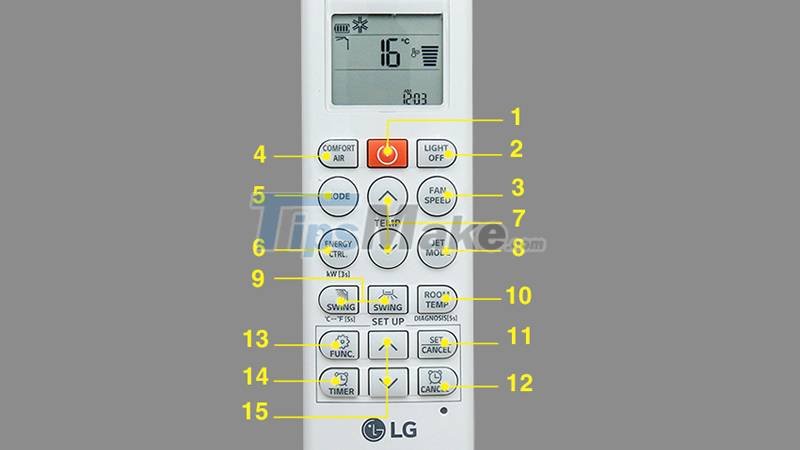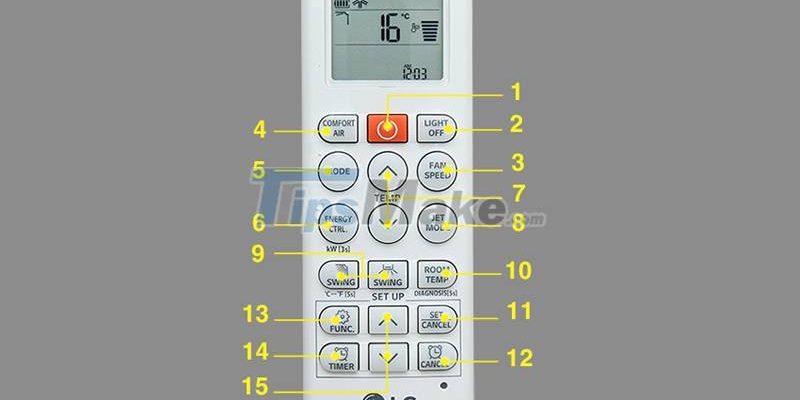
LG is one of those brands that puts a lot of thought into their air conditioner remotes, packing them with features. The trouble is, unless you’re the type who reads manuals for fun (I salute you), figuring out what each mode actually does—and which one you *should* use—can be a little overwhelming. That’s what we’re unpacking today: demystifying the different modes on your LG AC remote, how each one works, and zeroing in on which setting you’ll want for those sweaty nights, chilly mornings, or even just some good old fresh air.
Understanding the Basics: What Do “Modes” Actually Mean?
Let’s start at square one. When LG (or really any air conditioner brand) talks about “modes,” they’re basically talking about *personalities* your AC can take on. Each mode changes how the unit behaves—sometimes it’s blasting cold, sometimes it’s quietly moving air around, and sometimes it’s… well, just kind of chilling.
On your LG remote, you’ll probably see labels like “Cool,” “Fan,” “Dry,” “Auto,” and sometimes even “Heat” if your model supports it. Here’s the thing: these aren’t just decorative words. Pressing “Mode” actually tells the system how to handle temperature, fan speed, dehumidification, and more. Think of it like ordering coffee: “Cool” is your classic iced latte, “Dry” is more like cold brew with no ice—same beans, totally different vibe!
So, why not just leave it on whatever setting the last person used? Well, using the right mode actually *matters*—it can save you money, keep you comfortable, and even help your LG AC last longer. Each mode is built for a different purpose, and knowing which one to use (and when) is the difference between “Why is it so muggy in here?” and “Ahhh, perfect.”
Cool Mode: The Crowd Favorite for Hot Days
Okay, I’ll admit it: when I first started using my LG air conditioner, “Cool” was my default. It’s simple, it works, and it gets the job done. When you tap “Cool” on your LG remote, you’re basically telling your AC, “Hey, do your magic—bring down that room temperature now!” The compressor kicks into action, the fan starts swirling, and icy air floods the room.
If you’re sweating through your T-shirt or that summer sun is blasting through the window, this is the mode you want. But here’s a pro tip: don’t crank the temperature way down thinking it’ll cool faster. LG units cool at one steady speed—so setting your remote to 16°C won’t get you there any quicker than 24°C. It’ll just use more energy and might leave you shivering (or worse, dealing with a huge electricity bill).
Also, remember to keep the remote batteries fresh—those infrared signals need a good charge to communicate with your LG AC unit, and trust me, nothing’s worse than a dead remote mid-heatwave! If you ever feel like the “Cool” mode isn’t working right, it could be a battery or sync issue, so try resetting or re-pairing the remote to your AC.
Dry Mode: Beating Muggy, Sticky Weather
Ever noticed how some days, the heat isn’t the worst part—it’s the humidity that makes everything feel heavy, sticky, and just… gross? That’s where the “Dry” mode on your LG AC remote comes in handy. Tap that button, and instead of blasting cold air, your AC shifts gears to pull moisture out of the room.
It’s like turning your air conditioner into a giant dehumidifier. The unit runs its compressor less often and focuses on lowering the moisture level. You’ll still feel a difference in temperature, but it’s more subtle—no icy blasts, just a gentle, crisp coolness. I usually use this mode when it’s raining outside or during those late-night hours when the air feels “thick.”
If you live in a place where laundry never seems to dry or paper feels damp, try “Dry” mode for a few hours. You’ll be amazed at how much more comfortable the room feels.
Don’t forget, though, that “Dry” mode doesn’t replace a full-on dehumidifier—especially if you’re dealing with major moisture problems. Also, if your LG remote ever seems like it’s not switching modes, try checking the code or doing a quick reset. Sometimes, it just needs a little nudge.
Fan Mode: When You Only Need a Breeze
You might be wondering, “What’s the point of ‘Fan’ mode if my ceiling fan is already spinning?” Here’s the thing—LG’s “Fan” mode doesn’t cool the air, but it does circulate it. This is perfect for those in-between weather days when you don’t really need cooling, but you still want some airflow (maybe you’re trying to get rid of kitchen smells or just want to avoid stale air).
Switching to “Fan” is also *brilliant* for saving energy. No compressor means your AC is barely sipping on electricity—just enough to spin the fan. And if you’ve ever noticed your power bill creeping up during months when you don’t really need full-on cooling, using “Fan” mode more often can seriously help.
If your LG AC remote seems unresponsive in fan mode, or you can’t adjust the speed, double-check the batteries or try syncing the remote again. Sometimes, too many button presses can confuse the remote memory, so a reset might be in order.
Auto Mode: Set It and (Mostly) Forget It
Auto mode is for those of us who don’t want to fuss with settings every hour. What happens here is your LG AC uses its sensors to guess what you need and automatically shifts between cool, fan, or even dry, depending on the room’s temperature and humidity. It’s like giving your AC permission to babysit your comfort zone.
Here’s the thing: I used to avoid “Auto” because I thought I could “outsmart” the system. Turns out, the built-in chip does a better job than I ever could at maintaining a steady climate. It won’t cool as aggressively as “Cool” mode or dry as intensely as “Dry,” but for everyday comfort, it’s the Goldilocks choice—*just right* most of the time.
One catch: if your AC isn’t sensing the room right, it could be a sign of sensor misalignment or a remote issue. Try re-pairing or resetting your LG remote. And make sure you’re actually aiming the remote at the unit—infrared signals can be surprisingly fussy.
Heat Mode: Warming Up When It’s Chilly
If your LG AC is a split or inverter type with a heating function, you’ll see a “Heat” mode on the remote. This is basically your all-in-one system—cool in summer, warm in winter—and it can be a total game changer if you live somewhere with real seasons.
When you select “Heat,” the AC reverses its cooling cycle, pulling warmth from the outside air (even when it’s pretty cold out) and blowing it inside. I’ve used this on frosty mornings when my toes just won’t thaw out, and it’s honestly like magic. But heads up: it can take a little while for the warm air to kick in, so be patient.
If you’re struggling to get “Heat” mode working, check the remote code or try syncing it with the AC again—LG remotes sometimes need to be reset or paired after replacing the batteries. Remember, not all units support heating, so don’t panic if it’s missing from your remote.
Turbo/Jet Mode: Quick Relief When You Need It Most
There are days when you stumble home, sweat pouring down your back, and you want the room to cool off *yesterday*. That’s when “Turbo” or “Jet” mode (the name varies) becomes your best friend. This setting basically cranks every dial to the max, cooling the room as quickly as possible for a short burst.
It’s great right after you get home or if guests are coming over and you want to impress them with instant comfort. But here’s my advice: don’t leave your LG AC in Turbo mode forever. It uses a lot of power and can be unnecessarily noisy if you’re just chilling and watching Netflix.
If switching to Turbo doesn’t work, make sure your remote batteries are good, and press the button a little more deliberately—sometimes it’s a syncing or code issue, especially with universal remotes.
Comparing: LG Brand Remote vs Universal Remote Modes
Okay, let’s talk real world: what if you lost your original LG remote or needed something cheaper? Universal remotes can absolutely get the job done, but there are trade-offs. Brand remotes (the one that came with your LG AC) are coded perfectly for all modes and unique functions. Universal remotes? They’ll cover the basics—Cool, Dry, Fan, maybe Auto—but you might lose the finer controls, like Turbo or specific sleep settings.
Pairing a universal remote is usually a matter of code and patience. Sometimes you have to cycle through a bunch of codes before the remote syncs up perfectly. And not every universal remote can reset or pair as smoothly as the original.
If you’re using a universal remote and can’t seem to access all the modes, grab the manual or look up the LG AC remote code online. It’s often the solution to unlock those extra features!
But honestly, if you want the simplest, most reliable way to access every mode—including the weird ones you’ll only need once a year—stick with the original remote or a high-quality LG-compatible replacement.
Troubleshooting: What If the Modes Aren’t Working?
Sometimes, no matter how many times you press “Mode,” nothing seems to happen. First, don’t panic. Most issues with LG AC remotes boil down to a few simple things:
- Battery: Dead or dying batteries can mess with the signal. Always check (or swap in) fresh batteries first.
- Sync/Pairing: If you’ve just replaced the batteries or switched to a universal remote, sometimes the AC and remote need to be paired again. Follow the code setup in your manual—usually, it’s holding down a button or entering a specific digit sequence.
- Signal: Infrared remotes need a clear line of sight. Don’t try to change the mode from behind a wall or with something blocking the sensor.
- Reset: If all else fails, resetting both the remote and the AC unit can clear up stubborn glitches. There’s usually a tiny reset pinhole or an option in the remote menu.
I once spent a whole evening thinking my AC was broken—turns out, the batteries in the remote were just in backwards. Rookie mistake, but it happens!
Wrapping It All Up: Picking Your Perfect LG AC Mode
So, which mode *should* you use on your LG AC remote? It really depends on your needs, the weather, and honestly, your mood. Cool mode keeps things fresh when it’s extra hot, Dry mode tames that sticky-clothes feeling, Fan is perfect for light airflow, and Auto lets you kick back while your AC figures it out for you. If you’ve got heat and turbo features, those are great aces in your back pocket for winter chills or surprise guests.
The real trick is not being afraid to experiment—or, you know, push a button and see what happens. Just make sure your batteries are good, you’ve got a proper sync or code for your remote, and the sensors are clear. With a little knowledge and a dose of curiosity, your LG AC remote becomes less of a mystery box and more of a comfort machine.
At the end of the day, the best mode is the one that makes your space feel just right for *you*. And if your roommate, partner, or family member complains? Well, that’s what the remote’s “Mode” button is for—compromise, one click at a time.
